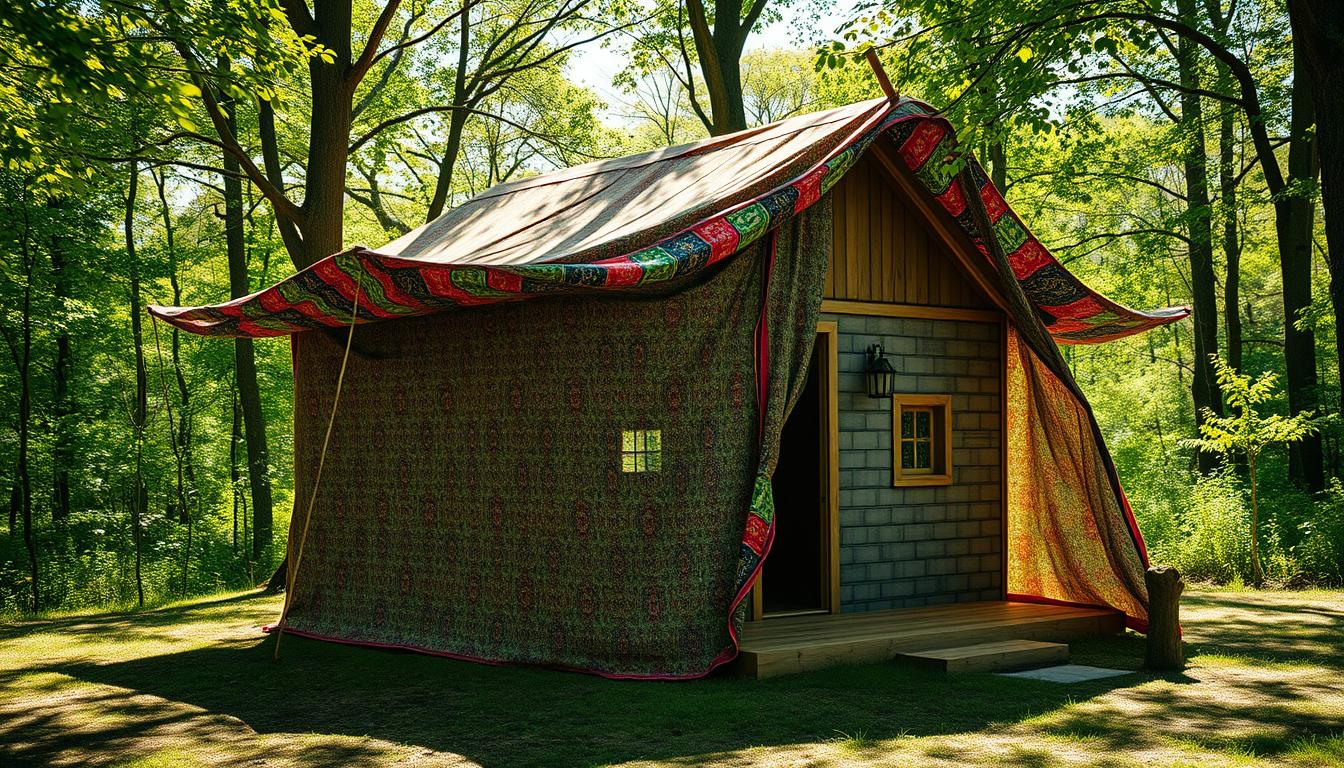Tiny house tents mix the ease of tiny living with the flexibility of fabric. They offer a unique option for those wanting a simple, green lifestyle without fixed homes. These structures balance comfort with the ability to move, attracting those who love adventure and care for the planet in the UK.
They use common materials like polyester, nylon, and cotton. This lets people make cozy, efficient homes that can be moved easily.
Starting a DIY tiny house tent project is a great way to reuse old stuff. About 20% of old tent materials are perfect for this. It’s good for the planet and boosts your design skills, with a 70% improvement in design abilities reported by DIY fans.
Also, buying second-hand cabin tents for as little as £35 is a smart way to save money.
Key Takeaways
- Repurposing old tent materials can lead to sustainable living while enhancing design skills.
- Polyester, nylon, and cotton are popular, lightweight, and durable materials for tiny house tents.
- Second-hand cabin tents offer a cost-effective source of materials.
- DIY tiny house tent projects provide flexibility and eco-friendly living solutions.
- 80% of campers prioritise not getting wet inside their tents, underscoring the importance of waterproof materials.
- Nylon’s natural resistance to bleaching and dyeing makes it a good choice for tent construction.
Understanding Tiny House Tents: Definition and Advantages
The tiny home movement is growing in the UK. Tent-style tiny homes are becoming popular. They offer a mix of tent charm and tiny home features. This makes them great for those who love nature and modern comforts.
What is a Tiny House Tent?
A tiny house tent is a small, easy-to-move home. It’s made from strong, light materials like polyester or nylon. It’s perfect for those who want to live outdoors but still have home comforts.
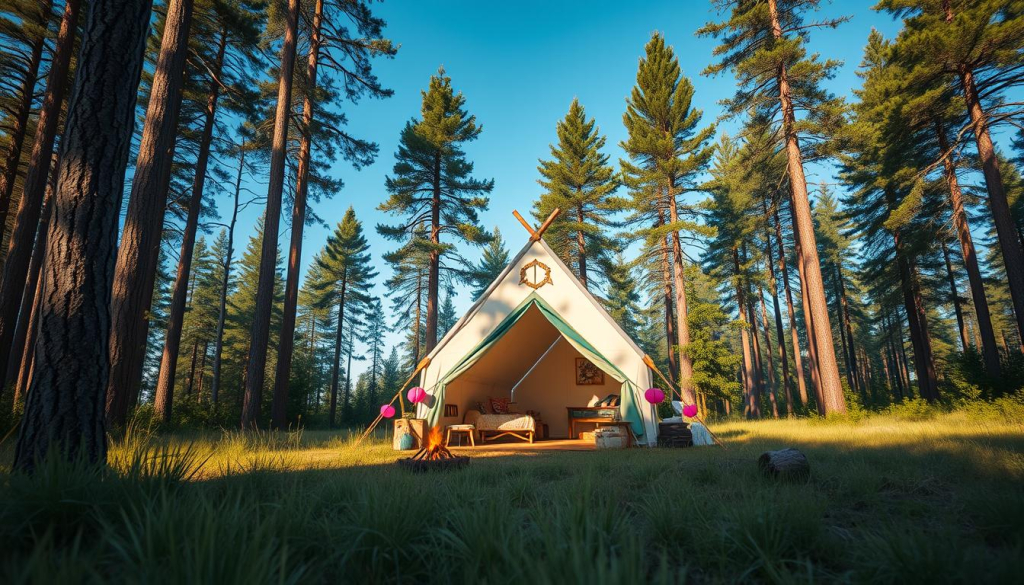
Advantages of Using Fabric for Tiny Homes
Choosing a fabric tiny home has many benefits. It’s cheaper to build and better for the environment. The light materials make it easy to move around, fitting well with changing seasons or personal needs.
Case Studies: Successful Implementations
Many places are using tiny house tents successfully. In Wales, they’ve helped create green tourism spots. In London, they’ve brought outdoor living to the city. These examples show how tiny house tents can work well in different places.
To find out more about tent-style tiny homes, check out Tiny House Expedition. They offer detailed information and expert tips.
Material Choices for Tiny House Tents
When picking materials for tiny house tents, think about comfort and durability. These tents are great for a portable tiny house or eco-hut. They need careful material choice to handle the UK’s weather well.
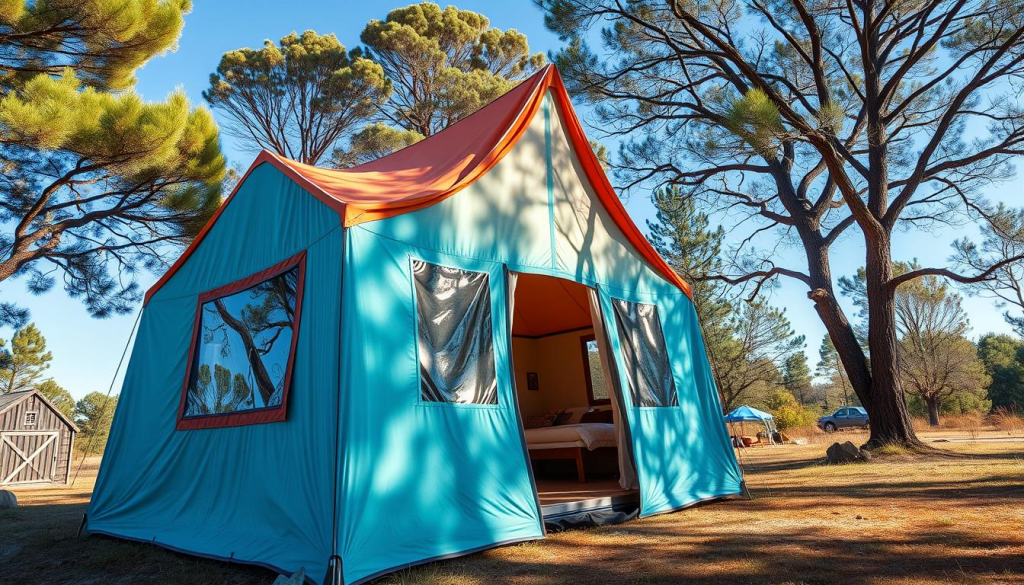
Popular Fabrics and Their Properties: Polyester, Nylon, and Cotton
Choosing the right fabric is key. Here’s what you need to know about the most popular ones:
- Polyester: It’s UV-resistant and durable. It’s often used for the tent flysheet, made from 10 to 70-denier polyester. Polyester keeps its strength and doesn’t shrink or stretch much, making it good for different weather.
- Nylon: It’s light and resists wear, perfect for the canopy and flysheet. Three-season tents use breathable nylon to manage moisture. Four-season tents use stronger nylon for stability.
- Cotton: It’s breathable and insulating. Cotton is heavier but feels natural and comfy inside the tent.
For more on picking the best materials for your tiny home, check out our guide here.
Considerations for Weather Resistance and Durability
When picking materials, think about weather resistance and durability. The UK’s weather can change quickly. You need strong, weather-resistant materials:
- Waterproofing: Tent fabrics should be water-resistant, with a minimum of 1000mm hydrostatic head rating.
- UV Resistance: UV-resistant materials protect the tent from the sun’s harmful rays, extending its life.
- Insulation: Good insulation keeps the tent comfortable. Factory Cabins’ tiny homes, for example, are well-insulated, with 250mm floors, 300mm walls, and 350mm roofs.
- Ease of Repair: Choose durable materials that are also easy to fix. This is especially useful for long-term use in eco-huts.
Lightweight and UV-Resistant Options
For a portable tiny house, material weight is important:
- Lightweight Fabrics: Nylon is great because it’s light and strong. Polyester is also good, balancing weight and durability.
- UV Resistance: Polyester and nylon both resist UV rays well. This is crucial for outdoor structures exposed to sunlight every day.
Choosing the right materials is about finding a balance. This creates a comfy and durable space in your tiny house tent. For more on picking materials, including a comparison of fabrics, see our detailed article here.
DIY Guide: Building Your Own Tiny House Tent
Starting a DIY tiny house tent project is both fun and rewarding. You can make a unique, functional, and minimalist micro home easily. This guide will help you design, find materials, and build your own tiny house tent, whether you’re experienced or new to building.
Planning Your Tiny House Tent: Key Features and Design
When planning your tiny house tent, start with a clear design. Think about these key elements:
- Ventilation: Good airflow is key for a comfy living space. Plan for openings or vents for air flow.
- Insulation: Insulation keeps it warm in cold nights and cool in hot days.
- Dimensional Specifications: Aim for a 15 feet (5 meters) diameter and 10 feet (3 meters) height at the centre.
- Frame Structure: Use lightweight yet strong materials like aluminium for a stable frame.
Gathering Materials: Where to Find and What to Look For
Finding good materials for your DIY tiny house is a mix of repurposing and buying new. Here are some tips:
- Outdoor Fabric Suppliers: Look for stores that sell 8oz wall canvas and 12oz roof canvas for waterproofing and anti-mould treatment.
- Repurposing: Use materials from old tents or projects. It’s eco-friendly and saves money. See examples on our tiny homes foundation page.
- Essential Hardware: Find wall timbers, wall bolts, and roof supports to make your tiny house tent strong and weather-resistant.
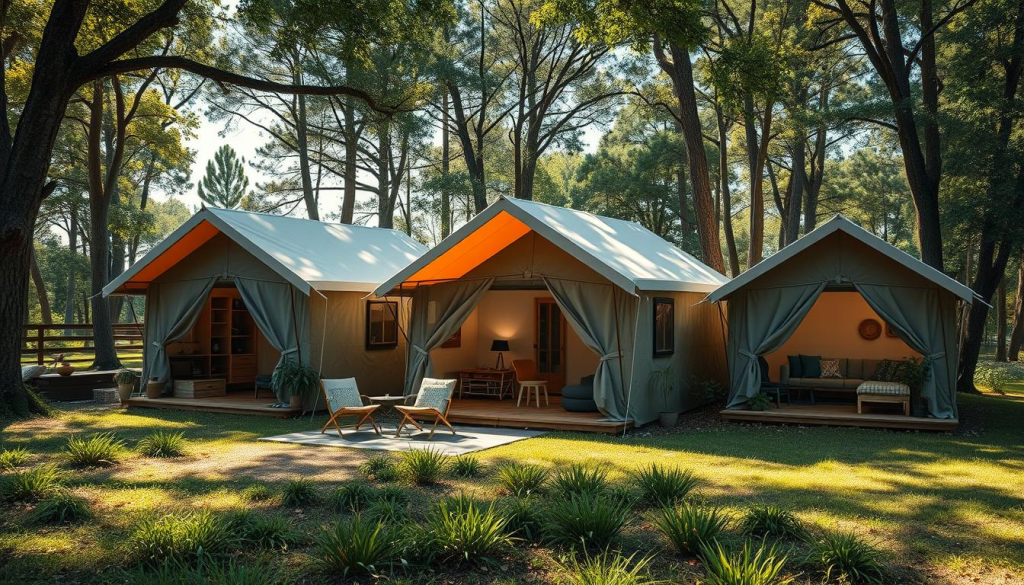
Step-by-Step Construction Process
Building your tiny house tent needs a step-by-step approach. Follow these steps for success:
- Frame Construction: Start with the frame using 8-foot long timbers for wall slats. Use 1” or 1½” long wall bolts with a 6mm diameter.
- Roof Assembly: Set up the metal roof hub and attach 8 main and 8 secondary roof supports, each 8 feet long.
- Canvas Application: Cut and stitch the canvas, treating it to make it waterproof and mould-resistant.
- Final Touches: Assemble the structure and check for stability. Make any needed adjustments for better integrity and weather resistance.
This modular outdoor accommodation is a minimalist micro home, offering flexibility and sustainability. By putting in time and creativity, you can make a unique tiny house tent that meets your needs and follows minimalist living. For more insights, visit our tiny homes foundation page.
Real-World Applications and Benefits of Tiny House Tents
Tiny house tents have many uses in real life. They offer benefits for eco-friendly homes, sustainable living, and affordable temporary housing. Let’s explore how these structures help in these areas.
Eco-Friendly Living: Reducing Your Carbon Footprint
Using tiny house tents means living in an eco-friendly way. They are made from sustainable materials. This reduces harm to the environment and saves resources.
These tents have good ventilation, insulation, and solar power. This makes them even better for the planet.
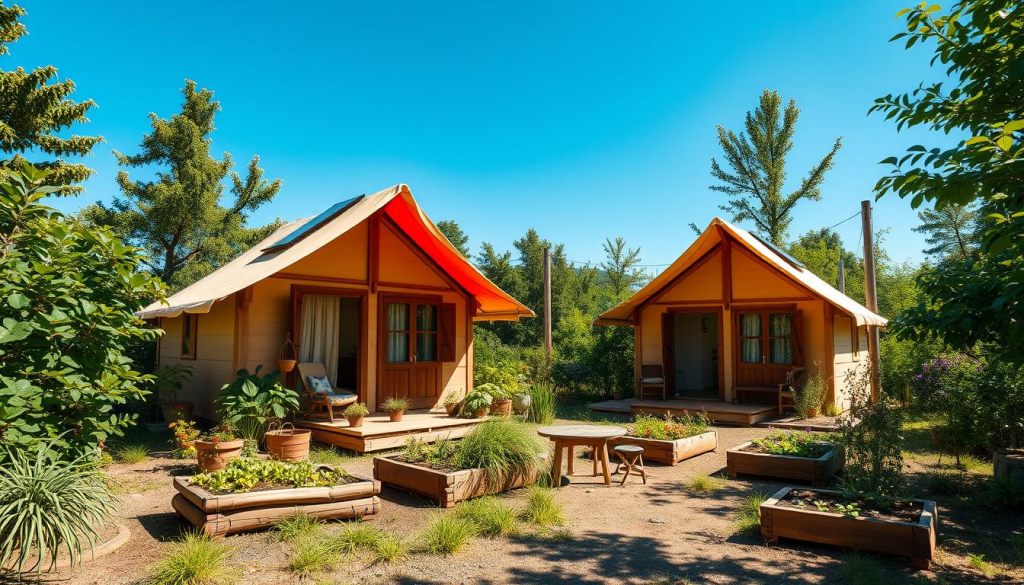
Versatility and Modular Capabilities
Tiny house tents are very versatile and modular. They can be designed to fit your needs. You can use them for travel, emergencies, or as a permanent home.
Their design can change easily. This makes them perfect for different places and uses. It also makes life easier and more enjoyable for users.
Cost-Effective Housing Solutions
Tiny house tents are also a budget-friendly option for housing. They cost less than traditional homes. This makes them available to more people.
Even though they are cheaper, they don’t lack in quality or comfort. This makes them a popular choice for many.
Conclusion
The rise of tent-style tiny homes marks a big change in the tiny house world. These homes, like the Avalon Bell Tent and Yurt Tent, are mobile, affordable, and good for the planet. They offer lots of space, up to 314 square feet, for a simple yet cozy life.
Tent living is eco-friendly, cutting down on carbon emissions compared to regular houses. Tiny homes use 45% less energy, as the U.S. Energy Information Administration found. This fits well with today’s push for green living. Plus, tiny house communities share resources, making it even greener.
These tents are also very flexible, making tiny living even more appealing. Geodesic dome tents, for example, arrive in 12-15 weeks, making it easy to move in quickly. Yurts, though pricier, are strong and weather-resistant, perfect for those who love the outdoors. Their mobile nature makes them great for anyone looking for a flexible home, whether for always or just for trips.
In summary, the growing love for tiny house tents shows a shift towards simpler, more adaptable living. This trend meets today’s need for eco-friendliness and cost savings. Whether you prefer the classic look of yurts or the cutting-edge design of geodesic domes, these homes offer a fulfilling, sustainable lifestyle.


